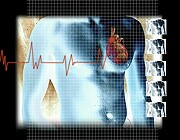
MONDAY, Nov. 18, 2013 (HealthDay News) — Damage to the blood vessels of the eyes or kidneys might help identify people who are at raised risk for a common type of heart-rhythm disorder, a new study suggests.
The disorder, called atrial fibrillation, is common in older people and increases the risk of stroke. It also can trigger heart-related chest pain or heart failure in some patients, the researchers said.
In the new study, which is scheduled for presentation Monday at the annual meeting of the American Heart Association in Dallas, researchers followed more than 10,000 middle-aged people for an average of almost 14 years.
Researchers led by Sunil Agarwal, of Johns Hopkins University in Baltimore, found that microvascular changes — trouble in the smaller vessels of the eyes or kidneys — appeared to be linked to the presence of atrial fibrillation.
For example, while about six out of every 1,000 people with no microvascular disease developed the heart-rhythm disorder, that figure rose to about nine out of every 1,000 for people with micro-bleeds or micro-aneurysms in the smaller vessels of the eye’s retina, the researchers said.
That number rose to almost 17 per 1,000 people for those with signs of vessel damage in the kidneys. It increased to more than 24 per 1,000 in people who had vessel damage in both the eyes and kidneys, the study found.
Why this vessel damage appears to be tied to a higher risk for atrial fibrillation remains unclear, the researchers said.
One expert not connected to the study theorized that small-vessel damage might be an underlying cause of atrial fibrillation.
“This [study] suggests that a potential trigger for developing atrial fibrillation may be worsening microvascular disease,” said Dr. Neil Sanghvi, an electrophysiologist at Lenox Hill Hospital in New York City. “Therefore, treatments that are able to minimize or prevent microvascular damage may be able to decrease the incidence of atrial fibrillation.”
Dr. Kenneth Ong is interim chief of cardiology at the Brooklyn Hospital Center in New York City. “Damage to the vessels in the eyes and kidneys are thought to reflect similar findings in the rest of the body, including the heart,” he said.
He added that it’s “reasonable to speculate” that patients with such damage might be at higher risk for heart disease.
Sanghvi said patients who have vessel damage in the eyes or kidneys “should consider long-term monitoring, on the order of one or two weeks,” to gauge their risk for undetected atrial fibrillation.
Experts note that findings presented at medical meetings typically are considered preliminary until published in a peer-reviewed journal.
More information
The U.S. National Heart, Lung, and Blood Institute has more about atrial fibrillation.
Copyright © 2024 HealthDay. All rights reserved.

